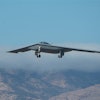A Boeing 737 jetliner filled with vacationers crashed in a thunderstorm and broke apart as it slid onto the runway on a Caribbean island Monday. Only one of the 131 people on board died, and the island's governor called it a miracle.
The plane hit short of the runway on Colombia's San Andres Island and skidded on its belly as the fuselage fractured and bits of landing gear and at least one engine were ripped off. The jet wound up on one end of the runway, crumpled and in pieces, as passengers scrambled or were helped to safety.
Of the 125 passengers and six crew members aboard the Aires airline jet, the only one killed was a 68-year-old woman, Amar Fernandez de Barreto, said San Andres Gov. Pedro Gallardo.
"It was a miracle and we have to give thanks to God," Gallardo said.
Officials were investigating a range of possible causes and looking into reports that Aires Flight 8520 was hit by lightning before the crash on the resort island, Colombian air force Col. David Barrero said.
"You can't speculate. Lightning? A gust of wind? The investigation will say," Barrero said by telephone from San Andres. "The pilot's skill kept the plane from colliding with the airport."
Officials said 119 people were treated or checked at clinics and five of them were seriously injured.
The airline said at least five U.S. citizens were on the plane, while the U.S. Embassy in Colombia said that four Americans and one U.S. permanent resident suffered injuries. The embassy said one critically injured American was being flown to Bogota for care, while the others were treated and released.
Airline representative Erika Zarante said four Brazilians, two Germans, two Costa Ricans and two French citizens also were on the plane.
The accident occurred so suddenly that the pilot did not report an emergency to the control tower, said Col. Donald Tascon, deputy director of the civil aeronautics agency. He said the plane's low altitude as it prepared to land — perhaps 100 feet (30 meters) just before the crash — may have averted worse damage.
Passenger Ricardo Ramirez, a vacationing civil engineer, told Caracol Radio that all had seemed normal, even though the plane was flying through a storm, with flashes of lightning, as it neared the airport.
"The plane was coming in perfectly. We were just about to land, everything was under control," he said. The accident "appeared out of nowhere."
After the plane hit and skidded to a stop on the pavement, Ramirez said he struggled to free himself and his wife from their seat belts.
"We tried to get out of the plane because the plane was starting to shoot flames," he said. "In a few minutes, a police patrol arrived and helped us."
Survival was "a miracle of God. Thanks to God we are alive," Ramirez said, though his wife suffered a dislocated shoulder.
Firefighters quickly doused the beginnings of a fire on a wing, police Gen. Orlando Paez said. He a group of police officers who were waiting at the airport for the plane to fly them back to the mainland aided in rescuing victims.
The jet crashed at 1:49 a.m. on the island, a resort area of 78,000 people about 120 miles (190 kilometers) east of the Nicaraguan coast.
Ninety-nine passengers were taken to Amor de Patria Hospital on San Andres, said Dr. Robert Sanchez, the hospital director. "It's incredible. For the dimension (of the accident), there should be more," he said.
Sanchez said an initial examination indicated that the single fatality may have been caused by a heart attack.
Twenty other passengers were treated at another clinic, according to the national civil aviation agency.
Among the seriously injured was a 12-year-old girl who suffered a broken pelvis, Gallardo said.
A 1½-year-old boy among the passengers wasn't listed among those with serious injuries.
Dr. Ricardo Villarreal, director of the clinic of the same name, said the pilot suffered some cuts to his face and was under observation. He identified him as Wilson Gutierrez.
The airline, Aerovias de Integracion Regional SA, said it has about 20 planes, including 10 Boeing 737-700 jets. It said in a Twitter posting that it was "working and investigating with the aeronautical authorities to determine the causes."
Barrero said scattered pieces of the plane blocked part of the 7,800-foot (2,380-meter) runway. But enough was usable that air ambulances would be able to land, he said.
Boeing said the 737-700 jet left the factory in 2003. It was not clear whether Aires was the first operator.
Aviation experts said it was too early in the investigation to speculate about what caused the accident.
At this stage in the probe, "you don't exclude any possibility, but investigators will be looking closely at the weather," said William Voss, president and CEO of the Flight Safety Foundation, based in Alexandria, Virginia.
Voss said a "sudden shift in wind direction can cause the aircraft to suddenly lose a lot of lift and end up landing short of the runway."
He and other experts say there can be hazards due to wind shear, violent shifts in wind direction and speed that can develop, especially beneath a thunderstorm.
Tascon said San Adnres' airport is not equipped with sophisticated equipment such as Doppler radar — which is used in many U.S. airports to help detect wind shear.
Larry Cornman, a physicist and expert on wind shear and turbulence at the National Center for Atmospheric Research in Boulder, Colorado, said he doubted lightning alone would be enough to bring down an aircraft. He said a strike would have to be powerful enough to pierce the aircraft skin and would have to hit a very specific location, such going through a wing and into a vapor-filled fuel tank.
Planes are designed to be protected from lightning, and because of their shape and metallic construction, lightning usually dissipates around aircraft rather than causing severe damage, Cornman said.
"You certainly don't expect to see catastrophic damage to an aircraft due to lightning," Voss said.
___
Associated Press Writer George Tibbits in Seattle contributed to this report.


















